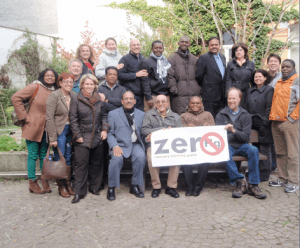
Our Community
In January, representatives from more than 140 nations met in Geneva and approved a new treaty to reduce the use and release of mercury worldwide and minimize its effects on people all over the world. Yet the need for tighter regulations on mercury have been on the civil society agenda of social and environmental organisations for a long time.
The Mercury Policy Project helped form and co-coordinates with the Brussels-based European Environmental Bureau the Zero Mercury Working Group — an NGO coalition of over 90 organizations from 52 countries — which began after the turn of the century to promote mercury reductions and cooperation internationally. While our network welcomes the treaty as a breakthrough opportunity, there is much to do to help make its high aspirations become a reality on the ground.
 The new treaty is a mixture of mandatory and voluntary elements intended to control the burgeoning global mercury crisis. While heading in the right direction, the treaty extends the time required to reduce mercury pollution over the next decade. For example, the instrument is hampered initially by lack of immediate controls on mercury emissions from major sources like coal-fired power plants, as well as those from artisanal and small scale gold mining, although it is designed to eventually control releases in the long term.
The new treaty is a mixture of mandatory and voluntary elements intended to control the burgeoning global mercury crisis. While heading in the right direction, the treaty extends the time required to reduce mercury pollution over the next decade. For example, the instrument is hampered initially by lack of immediate controls on mercury emissions from major sources like coal-fired power plants, as well as those from artisanal and small scale gold mining, although it is designed to eventually control releases in the long term.
However, there are many bright spots in the treaty. These include provisions to reduce mercury trade, prohibit the primary mining of mercury, and phase out mercury in most products, including in measuring devices (i.e. thermometers), batteries, pesticides, and cosmetics. Maximum mercury levels are also set for energy efficient lamps and phase down measures are required to reduce mercury use in dentistry.
Some of these steps were unthinkable just a couple of years ago. Now, alternatives exist for most all industrial processes and products containing mercury and the treaty sends the right market signal on phasing out all mercury uses globally.
Currently though, mercury poses risks for the environment and world’s population, since it’s a bioaccumulative persistent neurotoxin that can travel long distances through the atmosphere, respecting no national borders. Man-made sources of mercury released to the air (as a result of fossil fuel combustion, mining activity and waste disposal) contaminate our marine ecosystems and the species that live in them.
And if we eat those species — like tuna — mercury enters our bloodstream and can cause permanent damage to brain, kidneys and foetuses. It is particularly harmful to children and unborn babies because their nervous systems are still developing and to those who eat a lot of predatory fish. That’s why we have made it a priority to reduce exposure to mercury today, so that fish and seafood can one day be safe for future generations.
The new mercury treaty, in spite of its flaws, presents a tremendous opportunity for us to move our NGO agenda forward now. The next steps for our global NGO coalition include close adherence to promoting treaty development toward ratification and implementation of key provisions. At the same time, we will continue to promote mercury exposure and pollution reduction during the interim period to avoid wasting time and losing momentum that has been building in support of global action.
Given both the growing national and international interest to reducing mercury exposure globally over the past decade, we are optimistic that the world governments will follow through on their commitments and sign the treaty later this year in Minamata, Japan where the first major mercury poisoning epidemic occurred over 50 years ago now. We note that 3 countries (Japan, Norway and Switzerland) have already donated 1 million dollars each to help jump-start the mercury reduction work in the interim period and we plan to encourage more countries to do so.
After that, our goal is to promote ratification of the treaty by 50 countries as quickly as possible- hopefully within the next 2 to 3 years. Once that occurs, it’s expected that additional funding will be made available by the donor countries to foster treaty implementation globally. In sum, technology is available and affordable to reduce mercury emissions from most all major sources. But while there are also substitutes for most mercury uses, there is no substitute for global cooperation and collaboration.

Read the stories and hear the voices of social change leaders fighting for justice.